Date : January 27 - 29, 2016
Report: Press Tour to Hokkaido (Sapporo and Obihiro) “Turning Snow into an Advantage”
post date : 2016.04.01
The FPCJ planned and operated a press tour to Sapporo and Obihiro in Hokkaido, hosts of the 2017 Asian Winter Games, sponsored by the 8th Sapporo Asian Winter Games Organising Committee. Thirteen journalists joined the press tour, from Bangladesh, China, Hong Kong, Italy, Kazakhstan, South Korea, Spain, and the USA.
- Click here for further details on the tour
- Click here for a log of real-time updates from during the tour
<Day 1>
1. Okurayama Jump Stadium
The tour started with a visit to Okurayama Jump Stadium, which has been the site of many international ski jumping competitions. The journalists visited the Sapporo Winter Sports Museum, which has exhibits about the history of winter sports and a valuable collection of items from the 1972 Winter Olympics in Sapporo, and interviewed ski jumper Mr. Yukiya Sato and his coach Mr. Masahiko Harada. Questions included characteristics of Japanese ski jumping, the number of Olympic gold medals Japan has won in jumping events, and what kind of training Mr. Sato does.
At the observation lounge at the top of the jump, a member of the facility’s staff explained how Okurayama Jump Stadium is one of the few ski jumps located in a big city, making it convenient and easily accessible. The journalists also took the opportunity to take pictures of the Sapporo skyline that could be seen form the observation lounge.
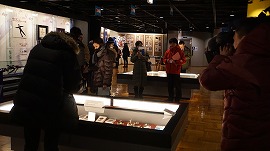

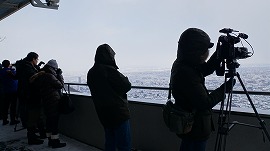
2. Sapporo Snow Festival Snow Statue Building Site
The tour visited one of the venues of the Sapporo Snow Festival, one week before the festival’s opening, to see snow statues being built. The journalists showed significant interest in this behind-the-scenes look, as the Snow Festival draws more and more foreign tourists every year. The Japanese Self-Defense Force, whose snow statues are always highly regarded, was in the process of building a snow statue of the Ruins of St. Paul's. Mr. Takatomo Morioka, former SDF officer and leader of the Sapporo City Snow Statue Production Group, explained that building snow statues is a type of defense training for the SDF, which caught the journalists’ attention. At a site where citizen volunteers were building a snow statue of the Hokkaido Shinkansen, the journalists interviewed volunteers from both Hokkaido and outside the prefecture about their reasons for participating in the Snow Festival and their opinions on it.
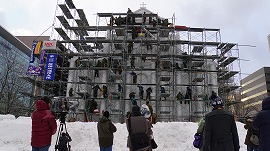

3. Yezo Deer Association and Tamaki Shoten, Co. Ltd.
The increase in Yezo deer numbers in Hokkaido has become a major issue in recent years, due to the damage they do to agriculture and their contribution to traffic accidents. The goal of the Yezo Deer Association is harmonious coexistence with the deer, and so they have been working on using deer meat as a resource in order to control the numbers of Yezo deer. The association’s director Ms. Yukiko Matsuura explained how she is also a hunter, and how she is working on building a network of female hunters with the motto of “hunting to eat.”
Mr. Yasuo Tamaki, president of Japanese tea manufacturer Tamaki Shoten, is also a hunter. In his case it is in order to protect the forest, which makes the delicious water needed for tea, from being devastated by Yezo deer. At the same time, in order to make use of the meat from the deer he hunts he developed deer tsukudani (simmered in soy sauce) as a product to sell, and provided some for the journalists to taste. After he explained that deer meat is high in protein and low in fat, journalists asked about the possibility of exporting it overseas.
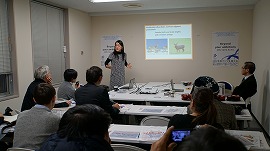
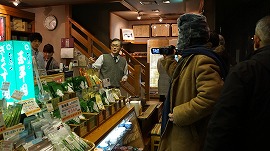
<Day 2>
4. Interview with Sapporo City Mayor
 Mayor Katsuhiro Akimoto explained Sapporo’s unique city initiatives to enjoy snow with festivals and sports, and to make use of it as a form of energy. In response to a journalist asking why more foreign tourists are visiting Sapporo, the mayor replied “For people from Southeast Asia, snow is unusual, and so it might be appealing to them.” There were also questions about the difficulty of dealing with large amounts of snow, the effects of Abenomics and the TPP, and the budget and economic impact of the Asian Winter Games.
Mayor Katsuhiro Akimoto explained Sapporo’s unique city initiatives to enjoy snow with festivals and sports, and to make use of it as a form of energy. In response to a journalist asking why more foreign tourists are visiting Sapporo, the mayor replied “For people from Southeast Asia, snow is unusual, and so it might be appealing to them.” There were also questions about the difficulty of dealing with large amounts of snow, the effects of Abenomics and the TPP, and the budget and economic impact of the Asian Winter Games.
5. Toshin Kita Snow-Melting Tank
The tour visited a snow-melting tank used to more efficiently melt snow in Sapporo’s city center, and to use energy derived from the collected snow and ice for air conditioning in the summer. A city official explained how the melting tank works, how much snow it can process, and the energy savings from using snow and ice energy. One journalist asked how snow removal for the city center was handled before the melting tank was completed, to which the reply was “about 50 trucks were used to transport the snow outside the city and to riverbanks.” Although an initial investment in the melting tank was required, environmental impact has been lessened with snow from the city center being efficiently dealt with in the city center. The journalists then took footage and photos of the melting tank, and performed interviews.
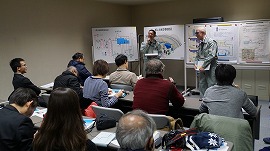
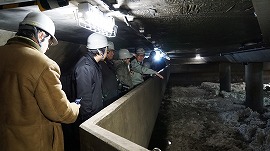
6. Moriura Farm
The tour visited Moriura Farm, where potatoes are ripened by storing them in warehouses with snow in order to make the potatoes sweeter, while the long-term storage also provides a stable year-round supply. The journalists heard from Mr. Masaaki Moriura, the 4th-generation head of the farm, about how starches change to sugars when potatoes are kept at low temperature and high humidity, the snow storage facility, and the types of potatoes he produces. Questions from the journalists were about storage methods and how the business was doing, and Mr. Moriura’s thoughts on Abenomics and the TPP. The journalists tasted the sweet potatoes that had been stored in snow, and seemed impressed at how delicious they were.
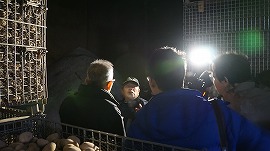
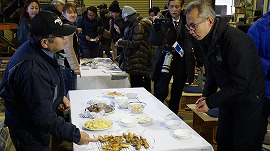
7. Obihiro Forest Speed Skating Oval
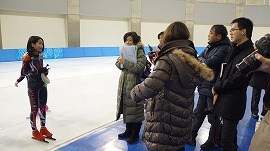 The tour then visited the Obihiro Forest Speed Skating Oval, which will be the venue for speed skating events during the 2017 Asian Winter Games. With the cold winters in Obihiro, the facility is popular not only for speed skating, but as a multipurpose venue for sports such as athletics, futsal, and tennis. Journalists interviewed the coach of a local skate club and some of its members by the rink where elementary and junior high school students were practicing their skating. One journalist commented “It is wonderful that they are able to practice at a facility like this since childhood.”
The tour then visited the Obihiro Forest Speed Skating Oval, which will be the venue for speed skating events during the 2017 Asian Winter Games. With the cold winters in Obihiro, the facility is popular not only for speed skating, but as a multipurpose venue for sports such as athletics, futsal, and tennis. Journalists interviewed the coach of a local skate club and some of its members by the rink where elementary and junior high school students were practicing their skating. One journalist commented “It is wonderful that they are able to practice at a facility like this since childhood.”
<Day 3>
8. Interview with Obihiro City Mayor
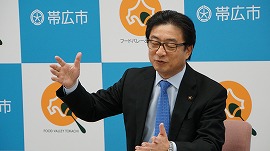 During the interview with Mayor Norihisa Yonezawa, questions included “What strategies are there for taking advantage of the harsh winters in relation to the plentiful agriculture in the area,” “What do you think of national policies such as the TPP and the food valley concept,” and “With foreign tourists increasing, particularly from China, what do you think could help improve Japan-China relations?” The mayor commented on the TPP by saying the city would work to increase overseas exports by improving food safety and added value, and indicated his belief that mutual understanding at the level of individual citizens is important for Japan-China relations. In response to the question of how many athletes from Obihiro City would be in the Asian Winter Games, he replied “I would like to see as many athletes as possible competing.”
During the interview with Mayor Norihisa Yonezawa, questions included “What strategies are there for taking advantage of the harsh winters in relation to the plentiful agriculture in the area,” “What do you think of national policies such as the TPP and the food valley concept,” and “With foreign tourists increasing, particularly from China, what do you think could help improve Japan-China relations?” The mayor commented on the TPP by saying the city would work to increase overseas exports by improving food safety and added value, and indicated his belief that mutual understanding at the level of individual citizens is important for Japan-China relations. In response to the question of how many athletes from Obihiro City would be in the Asian Winter Games, he replied “I would like to see as many athletes as possible competing.”
9. Noraworks Japan
The tour visited Noraworks Japan, where the cold of winter and heat from hot springs is used to grow mangoes in the Tokachi area. A unique feature of this company is that they harvest mangoes in the winter, by reversing the seasons in their greenhouses. The journalists saw how snow collected over the winter is used to cool the greenhouses in the summer, and the hot spring well used to heat the greenhouse in the winter. Mr. Hiroyuki Nakagawa, the president of the company, mentioned the difficulties he had at first in getting people to understand how he was going to cultivate mangoes in Hokkaido, and explained how he managed to start shipping mangoes three years ago. The journalists commented on how surprising this system was, using renewable energy and the natural environment to grow mangoes in such a cold area.

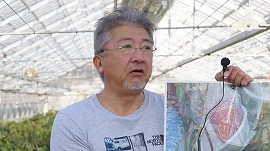
10. Ban’ei Horse Racing
Ban’ei horses contributed greatly to making Hokkaido into the agricultural powerhouse it is, and the tour visited the only racetrack in the world where horses compete while pulling weighted sleds. At the Horse Museum, the journalists saw how Ban’ei horses contributed to agriculture, how they were used in wartime, and the origins of Ban’ei racing. A mock race was held at the Obihiro Racecourse, and the journalists were able to experience the uniqueness of Ban’ei racing where it is possible to run alongside the horses and cheer them on.
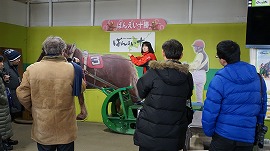
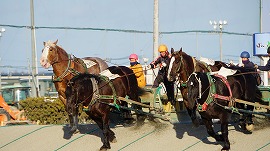
11. Liberty Hill Hirose Ranch
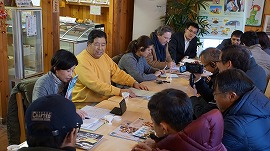 The tour concluded with a visit to Liberty Hill Hirose Ranch, which not only produces milk, but also makes ice cream using fresh milk. From Mr. Fumihiko Hirose, the 4th-generation head of the ranch, the journalists heard how he felt the necessity for a place to teach people about food through his interactions with children visiting the farm, and how the agreement on the TPP negotiations made him feel that it was necessary for farmers to become directly involved in processing and sales. Questions included “How much freedom do dairy farmers have in processing and selling milk,” “Do you think the agreement on the TPP is a good thing,” and “Are there any benefits from the harsh winters?” The journalists then saw the room for visitors and the barn where cows are milked, and had opportunities to film, take photographs, and perform interviews.
The tour concluded with a visit to Liberty Hill Hirose Ranch, which not only produces milk, but also makes ice cream using fresh milk. From Mr. Fumihiko Hirose, the 4th-generation head of the ranch, the journalists heard how he felt the necessity for a place to teach people about food through his interactions with children visiting the farm, and how the agreement on the TPP negotiations made him feel that it was necessary for farmers to become directly involved in processing and sales. Questions included “How much freedom do dairy farmers have in processing and selling milk,” “Do you think the agreement on the TPP is a good thing,” and “Are there any benefits from the harsh winters?” The journalists then saw the room for visitors and the barn where cows are milked, and had opportunities to film, take photographs, and perform interviews.



